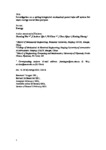Investigation on a spring-integrated mechanical power take-off system for wave energy conversion purpose
| dc.contributor.author | Wu, J | |
| dc.contributor.author | Qin, L | |
| dc.contributor.author | Chen, N | |
| dc.contributor.author | Qian, C | |
| dc.contributor.author | Zheng, Siming | |
| dc.date.accessioned | 2022-02-02T22:09:56Z | |
| dc.date.available | 2022-02-02T22:09:56Z | |
| dc.date.issued | 2022-04-15 | |
| dc.identifier.issn | 0360-5442 | |
| dc.identifier.issn | 1873-6785 | |
| dc.identifier.other | 123318 | |
| dc.identifier.uri | http://hdl.handle.net/10026.1/18639 | |
| dc.description.abstract |
In this work, a mechanical power take-off system (PTO) is proposed to be installed in a small-scale wave energy converter (WEC) to transfer wave power to electricity. Two pairs of one-way bearings are respectively embedded into two transmission chains to transfer bidirectional oscillation of the primary mover to unidirectional rotation of the generator. In addition to a flywheel mounted on the output shaft, a spring is integrated into each transmission chain to further smooth the generator speed. The working principle of the PTO is discussed in detail, including the situation of the PTO at different status combinations of the one-way bearings and the rules to determine the status combination in each time instance. Compared to the case when the flywheel is the unique smoothing device, a combination of the spring and flywheel significantly reduces the fluctuation of the generator speed. Two peaks are observed for the captured power versus the PTO configuration, and the one with a small spring stiffness and suitable generator damping is superior since a high power capture efficiency is achieved with a small fluctuation of the output power. Besides, the feasibility of the proposed PTO in smoothing generator speed in irregular waves is also verified. | |
| dc.format.extent | 123318-123318 | |
| dc.language | en | |
| dc.language.iso | en | |
| dc.publisher | Elsevier | |
| dc.subject | Wave energy converter | |
| dc.subject | Mechanical PTO | |
| dc.subject | Unidirectional | |
| dc.subject | Fluctuation | |
| dc.subject | Smooth | |
| dc.title | Investigation on a spring-integrated mechanical power take-off system for wave energy conversion purpose | |
| dc.type | journal-article | |
| dc.type | Journal Article | |
| plymouth.author-url | https://www.webofscience.com/api/gateway?GWVersion=2&SrcApp=PARTNER_APP&SrcAuth=LinksAMR&KeyUT=WOS:000792598600002&DestLinkType=FullRecord&DestApp=ALL_WOS&UsrCustomerID=11bb513d99f797142bcfeffcc58ea008 | |
| plymouth.volume | 245 | |
| plymouth.publication-status | Published | |
| plymouth.journal | Energy | |
| dc.identifier.doi | 10.1016/j.energy.2022.123318 | |
| plymouth.organisational-group | /Plymouth | |
| plymouth.organisational-group | /Plymouth/Faculty of Science and Engineering | |
| plymouth.organisational-group | /Plymouth/Faculty of Science and Engineering/School of Engineering, Computing and Mathematics | |
| plymouth.organisational-group | /Plymouth/REF 2021 Researchers by UoA | |
| plymouth.organisational-group | /Plymouth/REF 2021 Researchers by UoA/UoA12 Engineering | |
| plymouth.organisational-group | /Plymouth/Users by role | |
| plymouth.organisational-group | /Plymouth/Users by role/Academics | |
| dcterms.dateAccepted | 2022-01-26 | |
| dc.rights.embargodate | 2023-2-2 | |
| dc.identifier.eissn | 1873-6785 | |
| dc.rights.embargoperiod | Not known | |
| rioxxterms.versionofrecord | 10.1016/j.energy.2022.123318 | |
| rioxxterms.licenseref.uri | http://www.rioxx.net/licenses/all-rights-reserved | |
| rioxxterms.licenseref.startdate | 2022-04-15 | |
| rioxxterms.type | Journal Article/Review |


